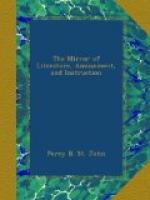THE MIRROR OF LITERATURE, AMUSEMENT, AND INSTRUCTION.
Vol. 20 No. 576.] Saturday, November 17, 1832. [Price 2d.
[Illustration]
Wingfield manor-house.
This interesting structure is referred to by a clever writer[1] as one of the richest specimens extant of the highly-ornamented embattled mansions of the time of Henry VII. and VIII., the period of transition from the castle to the palace, and undoubtedly the best aera of English architecture. This judgment will be found confirmed in the writings of distinguished antiquarians; and the reader’s attention to the descriptive details of this building will be important in connexion with several notices, in our recent pages, of old English domestic architecture.
[1] See the paper in part
quoted in our pages from the
Quarterly
Review, No. 90.
The manor of Wingfield, or Winfield, is situated four or five miles to the eastward of the centre of Derbyshire. The early lords had two parks, which, according to a survey made in 1655, contained nearly 1,100 acres. These parks are now divided into farms: on the border of one of them are a moat and other remains of an ancient mansion, traditionally said to have been called Bakewell Hall; by some, this is supposed to have been the original mansion, which is said by others to have been near the Peacock Inn, on the road between Derby and Chesterfield. The present Manor-House, (as represented in the Engraving,) according to Camden, was built about the year 1440, by Ralph, Lord Cromwell, in the time of Henry VI. This Lord Cromwell was treasurer of England; and the testimony of Camden that he was the founder, is strongly corroborated by the bags or purses of stones, (alluding to the office of treasurer which he filled,) carved over the gateway leading into the quadrangle. Bags or purses are mentioned to have been carved on the manor-house of Coly Weston, in Northamptonshire, augmented by this Lord Cromwell; and there were also similar ornaments carved in wood, removed about a century ago from Wingfield Manor.
The Manor-House originally consisted of two square courts, one of which, to the north, has been built on all sides, and the south side of it forms the north side of the south court, which has also ranges of buildings on the east and west sides, and on part of the south. The latter court seems principally to have consisted of offices. The first entrance is under an arched gateway on the east side of the south court. The arch of this gateway being a semicircle, was probably erected subsequently to the rest of the building: hence the communication with the inner court is under an arched gateway in the middle of the north side of the south court. One half of this range of building seems originally to have been used as a hall, which was lighted by a beautiful octagon window, and through a range of




